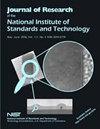3.5 GHz CBRS波段在位雷达信号射频数据集。
IF 1.3
4区 工程技术
Q3 INSTRUMENTS & INSTRUMENTATION
Journal of Research of the National Institute of Standards and Technology
Pub Date : 2019-12-17
eCollection Date: 2019-01-01
DOI:10.6028/jres.124.038
引用次数: 5
摘要
本文章由计算机程序翻译,如有差异,请以英文原文为准。
RF Dataset of Incumbent Radar Signals in the 3.5 GHz CBRS Band.
This Radio Frequency (RF) dataset consists of synthetically generated waveforms of incumbent 3.5 GHz radar systems. The intended use of the dataset is for developing and evaluating detectors for the 3.5 GHz Citizens Broadband Radio Service (CBRS) [1] or similar bands where the primary users of the band are Federal radar systems. The dataset can be used for developing and testing radar detection algorithms using machine learning/deep learning techniques. The algorithm aims to detect whether the radar signal is present or absent regardless of the signal type. The target signals have a variety of modulation types and parameters chosen from wide ranges. In addition, the start time and the center frequency of the radar signals are randomized in the waveform. The variety of signals and their random parameters makes the detection problem more challenging when using non-naive (e.g., energy detector is a naive signal detector) classical signal processing techniques.
求助全文
通过发布文献求助,成功后即可免费获取论文全文。
去求助
来源期刊
自引率
33.30%
发文量
10
审稿时长
>12 weeks
期刊介绍:
The Journal of Research of the National Institute of Standards and Technology is the flagship publication of the National Institute of Standards and Technology. It has been published under various titles and forms since 1904, with its roots as Scientific Papers issued as the Bulletin of the Bureau of Standards.
In 1928, the Scientific Papers were combined with Technologic Papers, which reported results of investigations of material and methods of testing. This new publication was titled the Bureau of Standards Journal of Research.
The Journal of Research of NIST reports NIST research and development in metrology and related fields of physical science, engineering, applied mathematics, statistics, biotechnology, information technology.

 求助内容:
求助内容: 应助结果提醒方式:
应助结果提醒方式:


